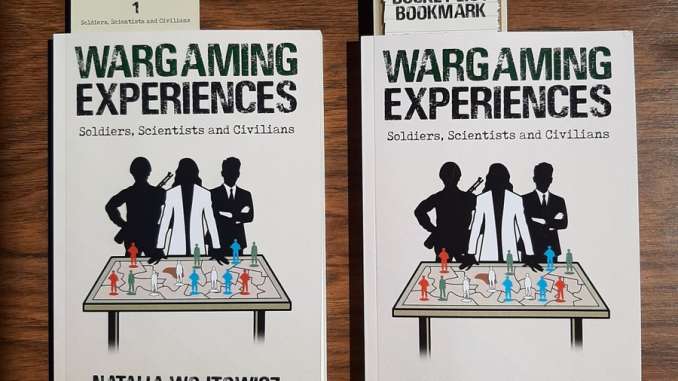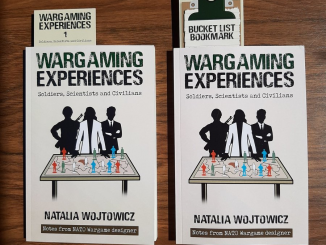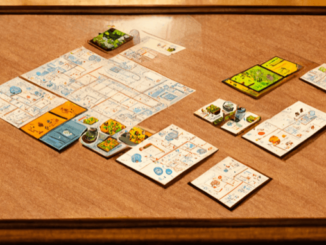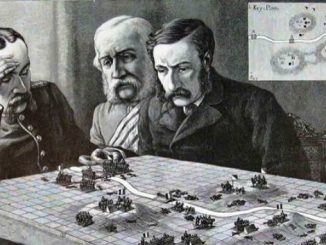
When my first book about wargaming came out (Ludogogy review) I received an urgent remark from my Father. He told me I have started with a guide on an advanced experimentation, but I have missed an introduction: “You need to invite people to understand, tell the story of wargaming, establish basic connection with reality.” In this article I hope to amend that omission and open the box of wargaming for common curiosity.
Admittedly it might seem that wargaming is a mysterious topic. It is very alive in the established circles of professional and hobby players, but it is almost absent from popular view. There is no equivalent of Monopoly, Wingspan or Azul that would be a frequent guest at family’s table. Prevalent perception is that playing wargames requires knowledge and effort to master broad set of rules for range of weapons, terrain conditions and maneuvers. But in in its essence, what is wargaming and how can everybody interact with it?
Wargames offer an insight into a conflict, situation or a system. If you would join a wargame, you would receive all the information needed to play: a map with noted positions, a role which you would take on, your units you can move or fight with and lastly, the objective. Or, in other words, the conditions of winning the game. In the picture below you can see the table set for two players who will be competing over contested elections in Belarus. One side fights to keep the presidency of Aleksander Lukashenka, the other one mobilizes the society to change it.

This prototype translates the unfolding events of mass protests in Belarus into an interactive experience. Taking the place of the commander or a leader triggers an influx of thoughts: what is this fight about? How can I change what I see on the table to my advantage? Do I have the chance to win? Humans understand things they can name, move and rule. The symbols on the table give a view into instinctively known lines, formations and strategies.
This initial interaction gives everyone an understanding of how wargames look, work and evolve. Any possible strategy you might conjure as a leader will eventually make it into a wargame, extending the options and creating new scenarios to play.
If the initial interaction proves engaging, the context of playing wargame can be examined. In most cases, it offers explanation as to why particular wargame is of interest or not and whether different design would be better for you. The first play can be telling in terms of preferences, expectations and possible outcomes. During the introduction for the students in the Hague University of Applied Sciences, I have chosen to play first and analyze later. This way, students have explored wargaming, looking towards elements of context that interested them. It is a point of start that can be reflected upon during next wargames.

Context of wargaming can include many elements:
- First impression of the player before the game starts – such as being comfortable or overwhelmed, curious or bored, experienced or not, searching for fun or for facts, leaning towards realistic or abstract scenarios, being pacifist or not;
- Explanation offered by facilitator – is it done in a clear and objective manner, does it convey the rules with precision, is it explaining the background of the wargame as well as its mechanics, lastly, does it create a beneficial atmosphere for the play;
- Cultural orientation of the wargame – such as design from a narrow or broad perspective (for example showing events from the perspective of winners), focus on topic (for example middle ages and castles), recognition of decision points and players (who is important and why, which story is being told).
After the initial interaction and the increasing understanding of the context in which wargaming takes place, there is room for discovery. Recognizing the context of wargaming reminds me of showing the same movie to different audiences, with expert introduction or without and to those that enjoy watching war movies or not. All these elements influence how the movie is received. The same can be observed for a wargame landing on the table and being played for the first time.
Among hundreds of wargames being published every year, majority is addressing historical battles, with a steady base in popular Second World War re-enactments. That is the most popular, but not the only way to discover wargaming. I have been considered as an outlier, because I have designed new formats and topics which are of interest to few. Such as the Belarus 2020 wargame, that showcases the events as they unravel. Or the Battle of Tabqa (Syria, 2017), seen from a perspective of a local engineer who worked on a Water Dam delivering power to the region. And with that completely alternative look I have met many experienced players that enjoy a new format for a wargame and those that tried to play because those topics were important to them. The take-away is that wargaming can serve as a way of experiencing the situation and creating unique insights, whether those pertain to historical campaigns or current problems.
Wargaming techniques have extended beyond entertainment, with academic and industrial experts reaching for the method in effort to view their problems from an active perspective. For example, a producer of coffee might want to see the market as a terrain they wish to dominate by outsmarting the other companies. In this wargame, you would play the CEO that is proposing ways to offer the most desirable product to the clients while maximizing profits. Other player might provide the view of the customer, keeping the choices of the companies in check and responding to the proposed changes. What can be observed as a result is an interaction between decision of one side and the reaction of the other.
The observations of dynamics brought the attention of academics who use wargames as simulations for collecting data or as a learning tool that engages students in complex problems. In this case, you might play a role of a governmental advisor writing the policy on anti-terrorism, while discussing with a legal advisor and testing the effectiveness of chosen approach on security of the country. Wargames can depict multi-actor systems and replicate structures of organizations, problems and people. They can translate static data into a moving, interactive play. Whether the design is dedicated to a scientific, business or entertainment purpose, wargaming creates a measurable play in which you can interact with a chosen environment.
Opening the box of wargaming mystery offers a new way of learning and discovering. Once you start interacting with a wargame you can recognize the moving parts of a structure, assess the mechanics in a design, judge the balance of the victory conditions and chances of winning. The better you can name those concepts, the more you can shuffle them. You start looking through the building blocks and into the context in which they were constructed. At this point you go from the person watching a movie to being an expert that recognizes how the plot was written, characters made, and the ending polished. Wargaming might look like a box on the shelf, but it is much more. It is a perspective and a way of thinking that sharpens our understanding of the world.
- The missing introduction to wargaming experiences - 9th November 2020





This is indeed, a great and easy to follow article. Thank you Natalia for sharing your wisdom (and your father’s advice).
Thank you Rodrigo. When the book first came out my Father was very proud and read the book cover to cover. He complained at the language and level of the information, saying that it needs to be more approachable. So I hope this small article will bridge the gap.
Interesting piece of writing, thanks for sharing it. You are write to suggest wargames can view complex situations through a different lens than just reading about something, watching a documentary or even discussing it.
Well done Natalia! I didn’t miss the introduction but that’s maybe because the concept of war gaming was not new for me. For readers who are new to the topic, this introduction might give them the needed understanding and appetite to fully enjoy and understand your book! Keep up the good war gaming work!